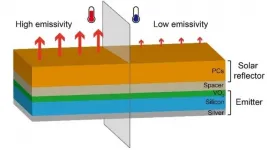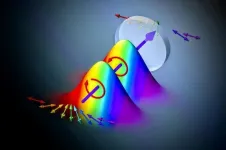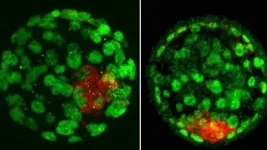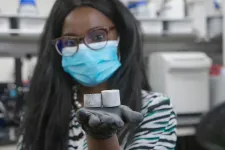Switchable diurnal radiative cooling by doped VO2
2021-06-21
(Press-News.org) In a new publication from Opto-Electronic Advances; DOI https://doi.org/10.29026/oea.2021.200006, Researchers led by Professor Junsuk Rho from Pohang University of Science and Technology (POSTECH), South Korea consider switchable diurnal radiative cooling by doped VO2.
As the impacts of climate change are increasingly felt, thermoregulation technologies that do not consume external energy have attracted considerable attention in the field of energy-saving applications. Radiative cooling has received much research interest for its ability to cool an object even under direct solar illumination. Nanostructured materials, or multi-stacked layers, can be designed to control reflection and emission spectrum to block solar irradiance and/or to emit heat through the atmospheric window. However, one limitation of radiative cooling for static devices, is that the cooling also occurs in low temperature conditions such as in winter or at night when heating is desired instead. Thus, there has been a strong demand for researchers to develop smart, switchable radiative coolers that cool down objects when the temperature is high but can also heat up in low temperature conditions.
Phase change materials that have distinct phases in response to temperature have been considered good candidates for such requirements. A doped vanadium dioxide (VO2) has a transition temperature at room temperature; the temperature-dependent characteristics of VO2 can be used to design a radiative cooler that cools down at temperatures above the transition temperature while heating up otherwise, without requiring any energy. This passive, but switchable, radiative cooling can directly provide environmentally friendly thermoregulation technology as well as various other applications such as air conditioning and heating.
The authors of this article propose a switchable radiative cooler that satisfies the aforementioned conditions using VO2. They have designed a switchable emitter by stacking VO2 on an insulator-metal layer. The resultant tri-layer structure emits its heat to the atmosphere above the transition temperature. This emitter is combined with a solar reflector, that is composed of several one-dimensional photonic crystals, to form a switchable radiative cooler. Thus, the overall system can block heat from solar energy while emitting thermal energy to the atmosphere.
The authors demonstrated that the switchable radiative cooler maintains a moderate temperature resilient to environmental changes by simulating a cycle of temperature changes under real outdoor conditions. The cooler facilitates self-adaptive thermal control and thus can be implemented in practical applications such as cooling buildings and vehicles.
INFORMATION:
Article reference: Minkyung Kim, Dasol Lee, Younghwan Yang and Junsuk Rho. Switchable diurnal radiative cooling by doped VO2. Opto-Electron Adv 5, 200006 (2021). doi: 10.29026/oea.2021.200006
Keywords: phase change material; photonic crystal; passive thermoregulation; switchable radiative cooling; Fabry-Pérot resonance
Professor Rho's research group in Pohang University of Science and Technology (POSTECH), South Korea, develops novel optical nanomaterials with a particular interest in sub-wavelength light-matter interaction and device applications. Examples include, but are not limited to, super-resolution imaging, negative index materials, scalable nanomanufacturing methodologies, metasurfaces for colour and hologram generation, topological photonics, acoustics/elastic metamaterials, and machine-learning assisted nanophotonics.
Opto-Electronic Advances (OEA) is a high-quality, open access, peer reviewed research journal that is published by The Institute of Optics and Electronics, Chinese Academy of Sciences. OEA provides a platform for researchers, academicians, professionals, practitioners, and students to impart and share knowledge in the form of high quality empirical and theoretical research papers covering the topics of optics, photonics and optoelectronics.
Since its launch in March 2018, OEA has expanded into a monthly publication schedule. From 2020 OEA is indexed by Science Citation Index Expanded (SCIE) and SCOPUS. From the current Web of Science (WoS) data, OEA expects that the June 2021 Journal Citation Report (JCR) should show that the journal has an Impact Factor of about 10.
More information: http://www.oejournal.org/oea
Editorial Board: http://www.oejournal.org/oea/editorialboard/list
All issues available in the online archive (http://www.oejournal.org/oea/archive).
Submissions to OEA may be made using ScholarOne (https://mc03.manuscriptcentral.com/oea).
ISSN: 2096-4579
CN: 51-1781/TN
Contact Us: oea@ioe.ac.cn
Twitter: @OptoElectronAdv
[Attachments] See images for this press release:

ELSE PRESS RELEASES FROM THIS DATE:
2021-06-21
Researchers at Tampere University and their collaborators have shown how spectroscopic measurements can be made much faster. By correlating polarization to the colour of a pulsed laser, the team can track changes in the spectrum of the light by simple and extremely fast polarization measurements. The method opens new possibilities to measure spectral changes on a nanosecond time scale over the entire colour spectrum of light.
In spectroscopy, often the changes of the wavelength, i.e. colour, of a probe light are measured after interaction with a sample. Studying these changes is one of the key methods to gain a deeper understanding of the properties ...
2021-06-21
Biologists at the Universities of Bath and Vienna have discovered 71 new 'imprinted' genes in the mouse genome, a finding that takes them a step closer to unravelling some of the mysteries of epigenetics - an area of science that describes how genes are switched on (and off) in different cells, at different stages in development and adulthood.
To understand the importance of imprinted genes to inheritance, we need to step back and ask how inheritance works in general. Most of the thirty trillion cells in a person's body contain genes that come from both their mother and father, with each parent contributing one version of each gene. The unique combination of genes goes part of ...
2021-06-21
Fat biomolecules in the blood, called "serum lipids," are necessary evils. They play important roles in the lipid metabolism and are integral for the normal functioning of the body. However, they have a darker side; according to several studies, they are associated with various cancers. The medical community has fathoms to go before truly understanding the implications of different serum lipid levels in cancer.
As a major step in this direction, a group of scientists from the Key Laboratory of Carcinogenesis and Translational Research, Laboratory of Genetics, Peking University Cancer Hospital and Institute; Hua County People's Hospital; and Anyang Cancer Hospital, have successfully determined that a family history ...
2021-06-21
(BOSTON) - Research collaborators from the VA, Boston University, and the Concussion Legacy Foundation (CLF) published an inspiring new report today, "1,000 Reasons for Hope," which exclusively details the first 1,000 brain donors studied at the VA-BU-CLF Brain Bank since 2008 and how they have advanced research on concussions and CTE. The report also explains how the next 1,000 brain donors will answer critical questions that take us closer to preventing, diagnosing, and treating CTE, as well as the long-term consequences of concussion and traumatic brain injury.
"Our understanding ...
2021-06-21
Johan Gaume, an EPFL expert in avalanches and geomechanics, has turned his attention to ice. His goal is to better understand the correlation between the size of an iceberg and the amplitude of the tsunami that results from its calving. Gaume, along with a team of scientists from other research institutes, has just unveiled a new method for modeling these events. Their work appears in Communications Earth & Environment, a new journal from Nature Research.
These scientists are the first to simulate the phenomena of both glacier fracture and wave formation when the iceberg falls into the water. "Our goal was to model the explicit interaction between water and ice - but that has a substantial cost in terms of computing time. We therefore decided ...
2021-06-21
An increasing number of studies on artificial intelligence (AI) are published in the dental and oral sciences but aspects of these studies suffer from a range of limitations. Standards towards reporting, like the recently published CONSORT-AI extension, can help to improve studies in this emerging field. Watch authors Falk Schwendicke and Joachim Krois of the Charité - Universitätsmedizin Berlin, Germany, discuss the Journal of Dental Research (JDR) article "Better Reporting of Studies on Artificial Intelligence: CONSORT-AI and Beyond," moderated by JDR Editor-in-Chief Nicholas Jakubovics, Newcastle ...
2021-06-21
When the COVID-19 pandemic hit during the winter of 2020, locking down entire countries and leaving people isolated in their homes without outside contact for weeks at a time, many relationship experts wondered what that kind of stress would do to romantic couples. What they found was that when couples blamed the pandemic for their stress, they were happier in their relationships.
The findings are outlined in a paper out today in the journal Social Psychological and Personality Science.
Previous research has shown that romantic partners tend to be more critical toward each other when experiencing ...
2021-06-21
Forces of nature have been outsmarting the materials we use to build our infrastructure since we started producing them. Ice and snow turn major roads into rubble every year; foundations of houses crack and crumble, in spite of sturdy construction. In addition to the tons of waste produced by broken bits of concrete, each lane-mile of road costs the U.S. approximately $24,000 per year to keep it in good repair.
Engineers tackling this issue with smart materials typically enhance the function of materials by increasing the amount of carbon, but doing so makes materials lose some mechanical performance. By introducing nanoparticles into ordinary cement, Northwestern University ...
2021-06-21
TAMPA, Fla (June 21, 2021) -- A blood gene profile associated with a high risk of dying from a severe lung disease can also predict poor outcomes in patients with COVID-19, a multicenter retrospective study led by the University of South Florida Health (USF Health) demonstrated. The risk profile based on 50 genes could help customize how COVID-19 is treated, improve allocation of limited health care resources such as intensive care beds and ventilators, and potentially save lives.
Idiopathic pulmonary fibrosis (IPF), a disease of unknown cause, affects the lung interstitium or the space between the lung sacs and the bloodstream, leading ...
2021-06-21
UNIVERSITY PARK, Pa. -- Using solar energy to inexpensively harvest hydrogen from water could help replace carbon-based fuel sources and shrink the world's carbon footprint. However, finding materials that could boost hydrogen production so that it could compete economically with carbon-based fuels has been, as yet, an insurmountable challenge.
In a study, a Penn State-led team of researchers reports it has taken a step toward overcoming the challenge of inexpensive hydrogen production by using supercomputers to find materials that could help accelerate hydrogen separation when water is exposed to light, a process called photocatalysis.
Both electricity and solar energy can be used to separate hydrogen from water, ...
LAST 30 PRESS RELEASES:
[Press-News.org] Switchable diurnal radiative cooling by doped VO2




